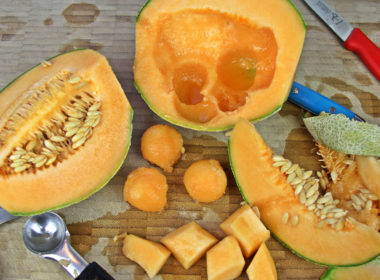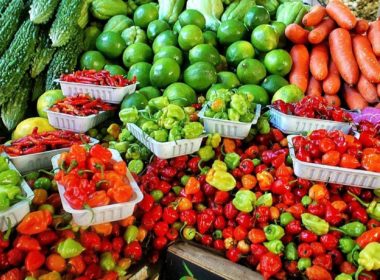Trinidad Scorpion Moruga The World’s Hottest Pepper.
So which pepper claims the record for the world’s hottest pepper? At the time of filming the video for this post, that title went to the Trinidad Scorpion Moruga (Butch T Scorpion) pepper, but word getting to me is that the title is now held by the Carolina Reaper and the Chocolate Bhutla peppers. So I’ve had to shift the focus of this article from being solely on the Trinidad Scorpion Moruga, to more of a ‘how to’ piece on handling such hot peppers.
1. Wear Gloves. When handling such hot peppers it’s important that you wear gloves. If the oils make contact with your skin it can be very painful and the pain will last for hours.
2. Even if you wear gloves, wash your hands with soap and water. Repeat!
3. When shopping for such peppers, look for plump peppers with no blemishes, green stems and peppers which are not cut or damaged. When fully ripe they can be red, yellow or orange (even chocolate). Peppers which are green in color simply means they are not fully mature (still very HOT) and to be quite honest I personally like using ‘green’ ones when I’m looking for more flavor than raw heat.
4. Storing. You can store Trinidad Scorpion Moruga, bhut jolokia, Carolina Reaper and Chocolate Bhutla on your kitchen counter for a few days, they will last in the fridge for a couple weeks and if you have a bumper crop you can place them (wash and dry first) in a thick zipper bag and freeze for months. They will maintain a high level of heat even if frozen.
5. Unlike typical Scotch Bonnet peppers, which tend to have the higher concentration of heat closest to the seeds, these varieties are hot the entire pepper. Normal scotch bonnets can be a bit less hot near the tip (bottom) of the pepper and as you work your way to the stems, the heat intensifies. This is not the case with Trinidad Scorpion Moruga, bhut jolokia, Carolina Reaper, Chocolate Bhutla and other extreme peppers. The seeds and white membrane surrounding the seeds is where you’ll get the RAW heat, so please be aware.
6. When making hot sauces (peppersauce) with Trinidad Scorpion Moruga, bhut jolokia, Carolina Reaper and Chocolate Bhutla I don’t recommend cooking these peppers indoor (if you cook your sauces). The scent will be choking to say the least.
7. If you want the flavor of the pepper in soups, stews, curries and other dishes, cook with the whole pepper (unbroken) and fish it out when the dish is done. The dish will have heat (not as intense as using cut peppers), but you’ll also get a wonderful flavor by using this method.
8. Chocolate. Do NOT be fooled when the word ‘chocolate” is attached to the name of the pepper, as it only applies to the color of the pepper and not the taste.
9. What to do when you try to be brave and you simply can’t handle the heat? Do not drink water and avoid alcohol. The capsaicin (heat oils of the pepper) won’t dissolve in water. Water spreads the burning to parts that weren’t previously affected and alcohol will magnify the burn. Acidic food or drink you can neutralize some of the activity of the alkaline capsaicinoid. Reach for cold lemonade, a lemon or lime, orange juice, anything tomato-based, or drinking milk (which is acidic). Milk, yogurt, and sour cream are acidic, which helps to combat the burning but in reality you’ll have to deal with some discomfort until the heat naturally fades away.





Really interesting and good advice.
The only thing that gets me is why/how people enjoy food with such extreme heat. I love scotch bonnet and bird’s eye, but I would never dream of using anything hotter than this. Like you, I prefer taste and a nice spark of heat, but I don’t like the heat to bite back!
there are many theories behind the hot thing from my own personal perspective there are a couple of reasons that come to mind. 1st is chilli/capsaicin, releases endorphins (especially when you eat them whole and raw straight off the bush like I do,) and this effectively gives you a high. Personally I find the hotter ones such as choc habanero and morugas and other chinense varieties are the better for doing this. 2nd there are health benefits to it they help with a number of bodily organ functions including lungs, heart and liver. they tend to have a cleansing and purifying effect upon the body and from my own personal experience I always feel better after eating a couple of nice hot raw chillis. 3rd they have some very intense flavours in the hotter varieties, Yes they are hot but there are also a lot of other flavour compounds that are really nice and are intense enough that when using them in cooking even a small amount of really hot chilli will give a lot to dishes other than heat. Anyway thats my 2 bobs worth!
Travis
I grew two of these Trinidad Moruga Scorpion Pepper plants from seeds this Spring/Summer in large pots in my yard. Believe you me they are HOTTER THAN HELL for sure! I did a lot off manual polination on the flowers and I harvested literally HUNDREDS of peppers from each fully grown plant until the first freezing temperatures did them in. I made beaucoup pepper sauces – one of which was based on your pineapple pepper sauce Chris – and I shared with friends and family and anyone interested in all things hot. I also froze a lot of the peppers which is a tip I got from you as well Chris. I will grow them again next year and perhaps try some different varieties as well. Thanks for all of the information Chris. Very helpful as are all of your wonderful recipes as well!
Hi Chris I am going to try and make one of these vesuvius type pepper sauces as my wife cannot find a pepper sauce hot enough for her she eats whole peppers fresh from the stalk and me being english can only put up with a modicum of heat, obviously my wife is from trinidad and has a long history of pepper sauce consumption I will let you know how it goes.
I’m just a farm boy from Iowa well man lol. Its my nickname I moved from Iowa to Ohio my girlfriend bought me 5 of the worlds hottest pepper seeds,being a farmer I know how to grow!!! Well I love hot foods I planted my scorpion-congo-ghost-red savina-fatalili seeds. They all produceded an I now have the worlds hottest salsa.I combined all 5 peppers.one bite mouths burning.2nd.bite numb lips.and etc.if you like hotter than hell stuff like myself combine all 5.
HI, I live in southwestern Ontario Canada. This year I grew 7 Pot Douglahs. So far I have picked 2 peppers and there are 4 more close to being ripe. Tried one a few minutes ago and OMG it was HOT! Do you think I can freeze these to use later?